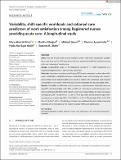Files in this item
Variability, shift-specific workloads, and rationed care predictors of work satisfaction among registered nurses providing acute care: : a longitudinal study
Item metadata
| dc.contributor.author | Abed Al Ahad, Mary | |
| dc.contributor.author | Elbejjani, Martine | |
| dc.contributor.author | Simon, Michael | |
| dc.contributor.author | Ausserhofer, Dietmar | |
| dc.contributor.author | Abu-Saad Huijer, Huda | |
| dc.contributor.author | Dhaini, Suzanne R. | |
| dc.date.accessioned | 2021-12-15T15:30:03Z | |
| dc.date.available | 2021-12-15T15:30:03Z | |
| dc.date.issued | 2022-03 | |
| dc.identifier | 277015667 | |
| dc.identifier | 3658c4ae-1aaf-47ab-8b84-77dee3d995cd | |
| dc.identifier | 85121368741 | |
| dc.identifier | 000730226100001 | |
| dc.identifier.citation | Abed Al Ahad , M , Elbejjani , M , Simon , M , Ausserhofer , D , Abu-Saad Huijer , H & Dhaini , S R 2022 , ' Variability, shift-specific workloads, and rationed care predictors of work satisfaction among registered nurses providing acute care: a longitudinal study ' , Nursing Open , vol. 9 , no. 2 , 1160 , pp. 1190-1199 . https://doi.org/10.1002/nop2.1160 | en |
| dc.identifier.issn | 2054-1058 | |
| dc.identifier.other | ORCID: /0000-0002-9006-730X/work/105007305 | |
| dc.identifier.uri | https://hdl.handle.net/10023/24517 | |
| dc.description | The proposed study was funded for 2 years (2018-2020) by the Medical Practice Plan, Faculty of Medicine, American University of Beirut, Lebanon. | en |
| dc.description.abstract | Aims: The aim of this study was to explore nurses’ shift-work satisfaction variability across time and its shift-specific predictors: perceived workload, patient-to-nurse ratio and rationing of nursing care. Design: Longitudinal study of 90 Registered nurses (N = 1,303 responses) in a Lebanese hospital over 91 days of data collection. Methods: Intraclass correlation coefficients (ICCs) were computed to determine shift-work satisfaction variability between individual nurses and working-unit clusters. Generalized linear mixed models were used to explore the workloads and rationed care predictors of nurses’ shift-work satisfaction separately for day and night shifts. Results: Variability in shift-work satisfaction was noted between individual nurses in day (ICC = 0.43) and night shifts (ICC = 0.37), but not between medical/surgical units. Nurses satisfied with their shift-specific work were less probably to ration necessary nursing care (OR = 0.68; 95% CI = 0.60–0.77) in day shifts and to perceive high workload demands in both, day (OR = 0.29; 95% CI = 0.23–0.37) and night (OR = 0.29; 95% CI = 0.18–0.47) shifts. Monitoring and lowering workload demands while observing rationing of care is necessary to improve nurses’ shift-work satisfaction. | |
| dc.format.extent | 10 | |
| dc.format.extent | 410114 | |
| dc.language.iso | eng | |
| dc.relation.ispartof | Nursing Open | en |
| dc.subject | Hospital | en |
| dc.subject | Longitudinal | en |
| dc.subject | Nursing | en |
| dc.subject | Patient-to-nurse ratio | en |
| dc.subject | Rationing of care | en |
| dc.subject | Shift-work satisfaction | en |
| dc.subject | Workload | en |
| dc.subject | RT Nursing | en |
| dc.subject | E-DAS | en |
| dc.subject.lcc | RT | en |
| dc.title | Variability, shift-specific workloads, and rationed care predictors of work satisfaction among registered nurses providing acute care: : a longitudinal study | en |
| dc.type | Journal article | en |
| dc.contributor.institution | University of St Andrews. Population and Health Research | en |
| dc.contributor.institution | University of St Andrews. Population and Behavioural Science Division | en |
| dc.contributor.institution | University of St Andrews. School of Geography & Sustainable Development | en |
| dc.identifier.doi | 10.1002/nop2.1160 | |
| dc.description.status | Peer reviewed | en |
| dc.identifier.url | https://onlinelibrary.wiley.com/toc/20541058/2022/9/2 | en |
This item appears in the following Collection(s)
Items in the St Andrews Research Repository are protected by copyright, with all rights reserved, unless otherwise indicated.

